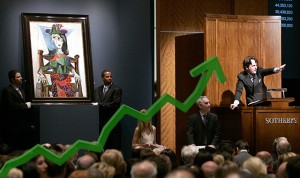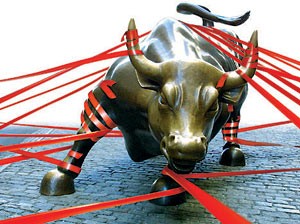Art
Fine art can be a good investment because, historically, the price fluctuations in the art market don’t reflect the ups and downs of traditional stock and bonds. During the second half of the 20th century, the value of art (based on the Mei Moses Fine Art Index), steadily increased at an average of 10.5 percent annually. However, while the stock market and the art market don’t usually peak and fall at the same time, art still experiences its own shifts that can make investing risky.
For example, fine art sales boomed during the late 1980s due to a surge in investment from Japanese investors, and again in the mid-2000s. But even the thriving art market couldn’t escape the 2008 global financial meltdown, though. The market has experienced a serious slump in the two years following, as well
Wine
Investors in fine wines can expect to make a steady return between 6 and 15 percent annually over the long term. Prices of certain vintages and of fine wines in general, fluctuate from year to year. But prices of wines from the most sought-after vineyards and vintages tend to increase eventually as the supply becomes scarce
Coins
Coins are valued, not for their weight in precious metals, but because of their scarcity. Popular collectible coins include Morgan dollars, Walking Liberty half dollars and certain Buffalo Nickels. Many factors influence how valuable a particular coin might be, including condition, which mint mark it carries and the year of issue. Mint condition coins are always more valuable than coins that are heavily worn. Certain years of coins had fewer minting, making them more rare and valuable.
In the coin market, the rarest coins tend to provide huge returns (upwards of 100 percent of their value in a year), while more marginally rare coins provide only modest returns (sometimes as low as 0 percent in a given year).
Commodities
Commodities include resources like crops and livestock, fossil fuels such as oil and coal, and precious metals like copper and gold. And the commodities market is one of the most volatile, since unpredictable natural disasters and world events have a direct impact on prices.
The safest way for individual investors to take advantage of the rising prices of commodities is to buy into exchange traded funds (ETFs); these are essentially mutual funds that purchase commodities or invest in commodity producing businesses. The safest ETFs purchase several different commodities, rather than focusing on one. ETFs can eliminate some of the uncertainty from choosing which commodities might rise and fall at a given moment
Private Equity
Private equity is investing in a company that does not issue public stock. Investors contribute capital to a company and then receive returns on their initial investment once the company reaches a certain stage, often an initial public offering of stock or a merger. Private equity investment has often funded start-up companies in high tech fields like telecommunications, biotechnology and recently, alternative energy.
The success or failure of an investment depends on how well a start-up company does, which is obviously a risky proposition even in a good economic environment. For this reason, high-net-worth individuals and venture capital firms have usually been far more active in private equity than small investors. Often, the investors have a hands-on role in shaping the management strategy of the growing company.
Hedge Funds
Hedge funds provide benefits to capital markets by contributing to market efficiency and enhancing liquidity. They often assume risks by serving as ready counter parties to entities that wish to hedge risks. Hedge fund can also serve as an important risk management tool for investors by providing valuable portfolio diversification.
Hedge fund strategies are typically designed to protect investment principal. Hedge funds frequently use investment instruments (e.g. derivatives) and techniques (e.g. short selling) to hedge against market risk and construct a conservative investment portfolio – one designed to preserve wealth.
Venture Capital
A specific type of private equity, venture capital focuses on start-up businesses that are at an extremely early stage in their business development. Venture capital firms provide start-up money for these companies and see a return when the company issues stock, or when another company purchases it. That return on investment usually does not come through for about 10 years, if at all.
Because venture capital firms invest at these companies in such an early stage, their investments are quite risky. However, they spread their capital over a broad array of companies to minimize that risk for the entire firm
Financial Derivatives
Financial derivatives are a category of securities that include futures, options, forwards and swaps. Basically, derivatives are an agreement between an investor and another party that will be paid out when a certain asset reaches a certain level. That definition might seem vague, but only because derivatives are a very broad category of security. In a futures contract, the investor agrees to buy an asset at a given price on a certain date. An option is similar, only the purchase is optional. A swap is when two parties exchange an asset, often to obtain a preferential interest rate
Real Estate
Historically, real estate has been a very popular alternative investment. Of course, the 2008 crash in the U.S. real estate market made many nervous about investing in real estate. But with prices still extremely low, real estate can be a good investment opportunity. The three most accessible ways to invest in real estate are to buy rental property as an individual, to join a real estate investment group or to buy shares in a real estate investment trust (REIT). Buying rental property can usually provide steady, reliable income if you find the right tenants. However, there are also expenses like property taxes and general upkeep that can limit profits, as well as huge investments of time and effort.









